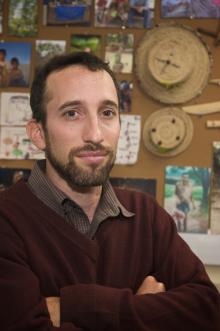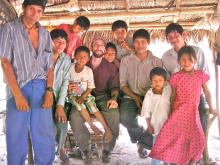
UCSB Anthropologist Studies Human Life Span, Evolution of Physiology

A remote Amazonian tribe in central Bolivia may offer proof that heart attack and stroke –– the leading causes of death in the United States and other developed countries –– were rare occurrences throughout most of human history. The tribe, known as the Tsimane, may also prove that chronic inflammation, a condition currently associated with cardiovascular disease, may not play as great a role as medical research has suggested.
"What we discovered is that inflammation doesn't always hold as one of the leading causes of heart disease," said Michael Gurven, professor of anthropology at UC Santa Barbara. "Chronic inflammation in the absence of other factors doesn't seem to increase heart disease."
Gurven's findings were published recently in the science journal PLoS ONE, but his research on the correlation between chronic inflammation and heart disease is only a small piece of a larger puzzle. He is studying the evolution of physiological systems –– immune, cardiovascular, renal, digestive –– that have contributed to humans' ever-increasing life span, but have also made them susceptible to a host of chronic diseases. Gurven believes that his continuing work with the Tsimane may call into question a variety of other commonly held medical beliefs.
"All humans are not the same. Local adaptations have been shaped for dealing with local environments," he said. "The more we learn about that, the more we learn that the hard and fast rules about risk factors in the biomedical tradition aren't so hard and fast. There are general ideas about what to do to stay healthy, but a lot of the details about why some lifestyle changes work for some but not others are unknown."
As an example, Gurven noted that many Tsimane suffer from parasites, a condition that may also offer the benefit of lower levels of total blood cholesterol –– particularly the LDL "bad" cholesterol –– and that parasites may shift the immune system in other ways that foster better heart health. He added that because parasites keep the immune system operating at a low but constant level of activity, allergies and asthma –– which result from the immune system suddenly going into overdrive –– are virtually non-existent among the Tsimane.
Gurven chose to study the Tsimane, who inhabit a vast area of lowland forests and savannas east of the Andes, because they still live a relatively traditional lifestyle –– fishing, hunting and gathering, and living in extended family clusters. Other groups with similar lifestyles exist, noted Gurven, but their very low population numbers make it extremely difficult to study older adults. "The Tsimane population is large enough that we can study almost all of the adults over age 40," he said.
Gurven conducts his research under the auspices of the Tsimane Health and Life History Project, which he co-founded in 2001 with Hillard Kaplan, a professor of anthropology at the University of New Mexico. The goal of the project is to understand the impacts of ecology and evolution on the shaping of the human life course. The focus is on health, growth, development, aging, economics, and biodemography of small-scale populations of hunter-gatherers and horticulturists. The project combines biomedical and anthropological research with medical attention among the Tsimane.
"I'm trying to understand the ecology of the past that has shaped the way our bodies function in traditional environments, and then use that knowledge to understand how our bodies function in modern environments. No single group can represent the past, and no group is pristine, but the Tsimane are closer than most," Gurven said.
The next step in his research is to increase his sample size. He is expanding his work to include over 35 additional villages, which will encompass over 95 percent of all Tsimane. Working with a medical doctor, he also plans to bring high-tech equipment to the field to conduct echocardiograms and ultrasound exams on the people to whom they provide medical care. "The true gold standard is looking at arteries," Gurven said. "We'll do echocardiogram on the carotid artery to look at a cross section and see how clogged it is –– or isn't. We anticipate very little clogging, if any, but if we do find it, it could be the case that it's not manifesting itself in typical heart disease."
Gurven and his team will also take a more in-depth look at other organs, including the heart, kidneys, and liver, to study the correlations between infectious exposure, organ damage and chronic diseases, such as diabetes, heart disease, or renal failure. "We're trying to see whether or not the pathology we see is a direct effect of pathogens or whether there's evidence of a similar disease process that we see here in the West," he said. "In the kidneys, we might see damage from infection, like from streptococcus bacteria. When we look at the heart, we might see damage from rheumatic fever or Chagas disease," Gurven continued. "In the West, when we see kidney disease or heart disease it's generally due to obesity, stress, diet, and other lifestyle factors."
Related Links



